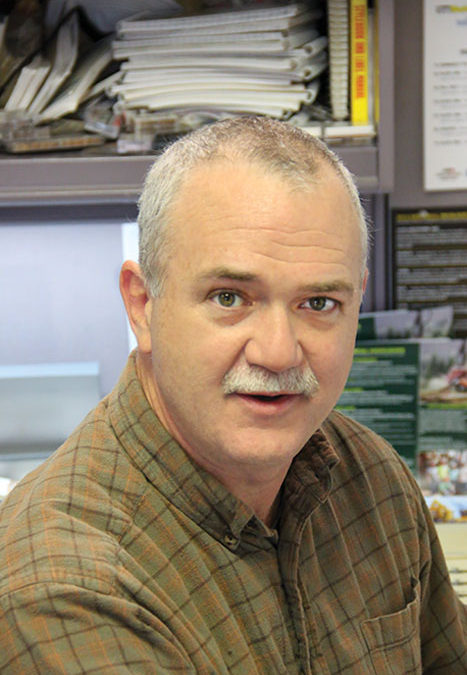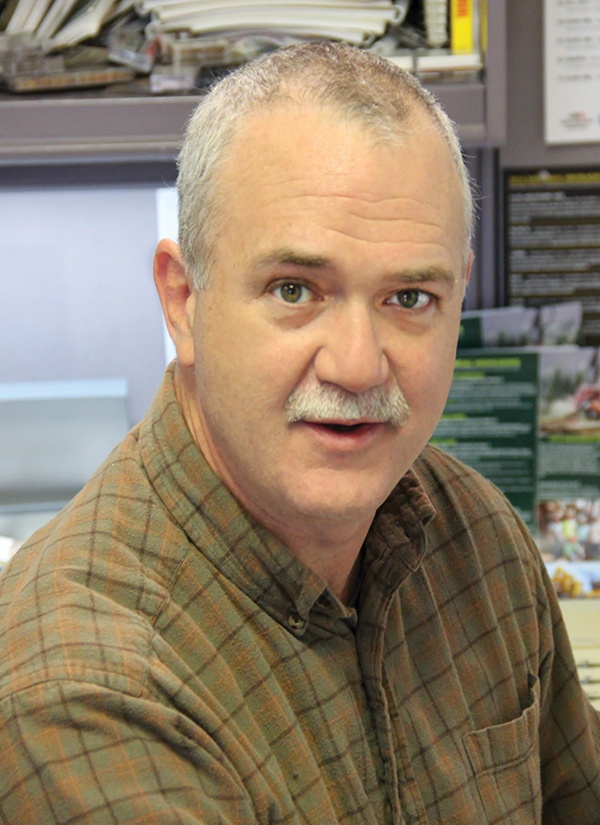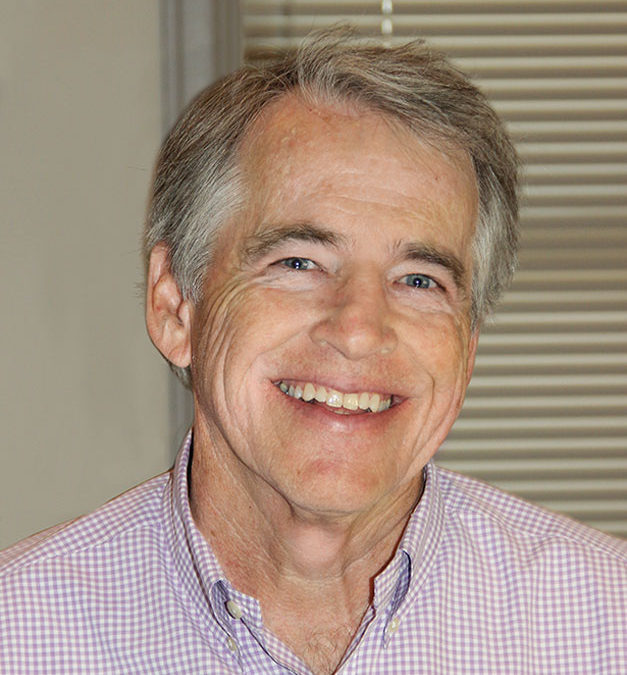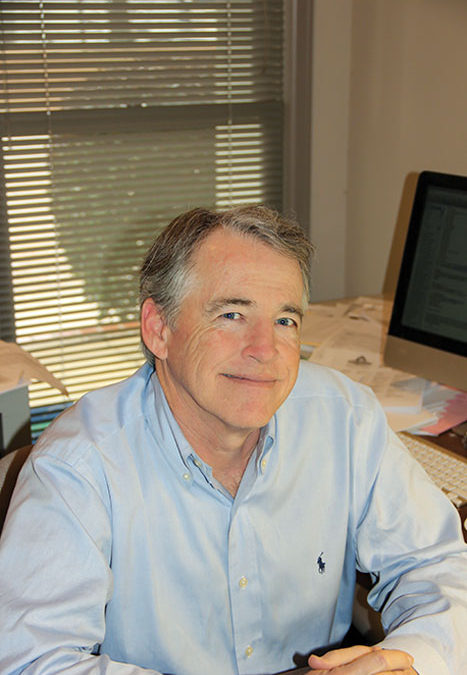
by Web Editor | Jun 21, 2017 | Taking Stock
Article by Dan Shell,
Managing Editor
Covering the Winston Plywood & Veneer story as Panel World has ever since the original project was announced, well before the “tornado that changed everything” on April 28, 2014, seeing the project come to fruition after rising from ruins is gratifying—and one more in a line of stories PW has done that document panel industry reinvestment and renewal following fires primarily, but also other disasters such as the tornado that struck Louisville, Miss. three-plus years ago.
Past stories of large rebuilds or investment include Boise Cascade’s major rebuild following a fire at its large Medford, Ore. plywood facility, and Murphy Co. rebuilding with a state-of-the-art LVL plant in Sutherlin, Ore. following a disastrous fire in 2005. And after visiting Winston Plywood & Veneer in late spring, Panel World is also looking forward to touring Swanson Group’s new plywood facility now in startup in Springfield, Ore. following a devastating July 2014 fire.
In Mississippi, economic development officials touted the teamwork that developed as the rebuilding project came to life. Glenn McCullough, executive director for the Mississippi Development Authority, noted that “Winston Plywood and Veneer is creating a model for manufacturing across the state, the country and world. They understand it takes quality people, quality products, great teamwork and planning.”
Indeed, Winston Plywood & Veneer has received a national award for its economic impact and projected impact on Louisville and Winston County. The mill is one of 15 recipients of the 2016 Corporate Investment and Community Impact Award, which is presented by Trade and Industry Development magazine.
The site selection publication credited the company for its work to reopen the plywood mill in Louisville and making the commitment to reinvest in the facility and the community. The plant will ultimately employ more than 300, and built-in extra capacity that can be brought on line as needed is enough to make the facility one of the largest North American plywood plants.
Winston Plywood & Veneer shipped its first product in November 2016 but held a “grand reopening” ceremony this past April.
“When we broke ground here two years ago, in the aftermath of a devastating storm, we said we would stay the course until we delivered and opened the finest plywood mill in North America. I am very proud to say today that we have kept that commitment, and that the future for this business is bright,” said Andrew Bursky, Chairman and Co-Founder of Atlas Holdings LLC, the parent company of New Wood Resources LLC, owner of Winston Plywood & Veneer.
And while rebuild stories like Boise at Medford, Murphy’s LVL plant and Winston Plywood & Veneer get many of the headlines, dozens of similar stories abound in the panel industry of companies reinvesting after smaller fires or accidents, upgrading operations and emerging better than before.
In each case, there’s a grateful and usually cooperative local community that has worked in any number of ways to keep from losing good jobs and facilities that have a jobs multiplier effect considering the additional businesses that supply or otherwise serve a panel mill.
Of course, the numbers have to make sense to make reinvestment a reality. (A good local wood basket always helps.) And there are any number of unique factors surrounding every mill rebuild decision. But to see such a cooperative effort among state and local communities to sustain the Winston Plywood & Veneer project is a welcome sight indeed.

by Brad Jackson | Apr 10, 2017 | Taking Stock
 Article by Dan Shell, Managing Editor, Panel World May 2017
Article by Dan Shell, Managing Editor, Panel World May 2017
The LP Clarke OSB plant profiled in this issue and the story of its origin, derailment and ultimate resurgence serves as an analogy for the panel and home building products industry during the past decade: Big plans and a startup halted by a fire and historically bad panel markets, but an eventual rebound and restart in 2013 as business conditions grew more favorable.
Looking back now, with the benefit of hindsight, the warning signs of America’s biggest economic downturn since the Great Depression were already there a decade ago: By 2004, U.S. homeownership had peaked at 70%. Then, during the last quarter of 2005, home prices started to fall, which led to a 40% decline in the U.S. Home Construction Index during 2006. During February and March 2007, more than 25 subprime lenders filed for bankruptcy.
In late 2006, APA Chairman Jonathan Martin, CEO of RoyOMartin and whose company was about to start up a brand new OSB plant, saw the signs: At the APA—The Engineered Wood Assn. annual meeting, Martin exclaimed in a presentation that “We need more demand. Housing is slower. Capacity is rising.”
Going into the downturn, Martco started up its OSB plant at Oakdale, La. and LP started up about a year later in Thomasville, Ala. In previous years Huber had started up in Broken Bow, Okla., GP in Hosford, Fla., LP/Slocan at Fort St. John, BC, Tolko Industries at Meadow Lake, Saskatchewan, and some others as well.
In such a situation as the extreme downturn of 2007-8-9, there’s no hiding under a rock. Despite weakening markets, panel producers had to adjust and make the best decisions they could while hoping the worst didn’t get worse. Survivors from that period are well-versed in what happened next as a run of definite and indefinite plant closures was accompanied by widespread shift reductions.
And while it seemed every piece of industry news when describing bad markets, housing starts and overall business prospects during that period included the phrase “not seen since the Depression,” the sun did creep out again.
Markets returned—to an extent. Prices are certainly better. And while housing starts haven’t recovered from the highs of 2004-5, the current 1.2-1.3 million starts sure look better than 400,000 in 2010.
In recent years, several mills re-opened, such as Arbec Forest Products at Miramichi, New Brunswick, GP at Clarendon, SC, Tolko at Slave Lake, Alberta, LP at Thomasville. Other OSB operations jostled into position, including Norbord’s acquisition of Ainsworth. Now we’re hearing talk of possible restarts at Norbord in Huguley, Ala., Tolko at High Prairie, Alberta, Huber at Spring City, Tenn. And don’t forget Martco’s new greenfield OSB plant in Corrigan, Tex. that is expected to start up later this year.
Along the way, North America OSB production has rebounded, going from 16.78 billion SF in 2012 to 21.84 billion SF in 2016. There’s renewed optimism with what’s expected to be a pro-business administration in Washington, DC.
But actions speak louder than words, and in the OSB sector, companies like Martco, LP and others are letting their actions speak for themselves.
RELATED ARTICLES
OSB OUTPUT HAD UPTICK IN 2020
The monthly Panel World Industry Newsletter reaches over 3,000 who represent primary panel production operations.
Panel World is delivered six times per year to North American and international professionals, who represent primary panel production operations. Subscriptions are FREE to qualified individuals.
Complete the online form so we can direct you to the appropriate Sales Representative. Contact us today!

by Brad Jackson | Feb 20, 2017 | Taking Stock
Article by Rich Donnell,
Editor-In-Chief
The world’s largest producer of oriented strandboard isn’t holding back on its criticism of United Kingdom electricity produced with wood biomass.
Norbord’s European operation, which has been dogging biomass power for several years, has ramped up its attack in recent months, saying it’s not fair for UK taxpayers to have to foot the bill; that the burning of wood is not a sustainable source of energy but rather creates more carbon emissions than burning coal; that the diversion of wood raw material for this purpose distorts the traditional wood market and drives up prices for timber and residues; and that the wood pellet procurement chain poses a threat to bottomland forests especially in the Southeastern U.S.
It’s no secret that our publishing operations also produce Wood Bioenergy magazine, in addition to Panel World, and that we organize back-to-back conferences every two years in Atlanta, Georgia—the Wood Bioenergy Conference & Expo and the Panel & Engineered Lumber International Conference & Expo. Dozens of exhibitors participate in both conferences. You see many familiar faces at these conferences who have switched from one industry to the other. We tend to view this dichotomy as a family affair.
Norbord’s arguments above are valid, but we’ve all read counterpoints to each one of them. If a government is pushing for renewable energy, shouldn’t it be expected to provide some measure of subsidization at least for a period of time? Shouldn’t the fact that forests have been sucking in carbon for years be figured in the carbon emissions equation? Didn’t the emergence of OSB divert wood raw material away from the traditional pulp and paper industry? How much timber that’s to be used in wood pellet production is really coming out of bottomland forests?
The arguments on both sides of the fence seem to have lots of merit. We should know, since we have to straddle that fence.
We do have one concern, however. As we note in an article on page 8, Norbord teamed up with several organizations and signed a letter to the UK secretary of energy, registering their criticisms and asking that the UK review its bioenergy policy.
The letter is signed by a Norbord officer, as well as an officer from the Wood Panel Industries Federation, which represents several European structural and non-structural board manufacturers, including Norbord. Fair enough. But also signing the letter were representatives of the Natural Resources Defense Council and the Dogwood Alliance.
When I think of the Natural Resources Defense Council and Dogwood Alliance I think of organizations whose mindset is against real forest management and timber harvesting.
We have no problem with Norbord and forest products companies voicing their concerns about wood biomass power. That’s what’s in their best interests. We also understand that signing the dotted line along with preservation organizations in this matter is a temporary political alliance. But it still makes us uncomfortable. We all know that tomorrow these preservationist groups will be signing the dotted line in protest of our industry.

by Web Editor | Aug 17, 2016 | Taking Stock
Article by Rich Donnell,
Editor-In-Chief
This issue of Panel World reports on several interesting developments, one of which is EPA’s release of its “final rule” on formaldehyde emission levels for composite panels and the related certification and recordkeeping stipulations. It’s similar to the CARB rule that originated in California, to which industry is no stranger.
I printed out the 272-page ruling and made some of the editors aware it was there and invited them to digest it. Suddenly the editors all left on vacation. I suppose it should have fallen into my lap, since I have some historical perspective of the formaldehyde issue, which I didn’t dare tell them because they tend to laugh at me when I say things like that.
However I do know that the formaldehyde issue surfaced in the early 1970s when Charles Morschauser, who was the technical director of the National Particleboard Assn., told Bill Ives, who was legal counsel for the association, that someone had raised a question about whether or not because of the off-gassing of formaldehyde, companies should be concerned because it might violate the federal law that prohibits the shipment of chemicals. Ives said it might be an issue but he wasn’t sure if the association wanted to tackle it yet, and so they sent a notice to all the companies that this may present an issue at some point and meanwhile to handle it individually.
Then other things happened. Some manufactured home occupants complained of irritation, leading to a 1979 study by the Chemical Industry Institute of Technology that found that over a two-year period, high levels of inhaled formaldehyde—15.0 ppm no less—caused nasal cancer in lab rats. Then Consumer Products Safety Commission investigated a few installation problems with urea formaldehyde foam insulation (UFFI) used primarily as retrofit insulation in older houses; and then some lawsuits surfaced against wood panel and UFFI suppliers and home builders that placed a stigma on the resale of houses containing UFFI; and then there was the accompanying media coverage that found the particulars too complex to delve into and caved in to environmental sound bites.
The issue turned into a major discussion in the 1980s between health scientists, regulatory agencies and industry. The particleboard/MDF industry reacted swiftly and worked with the adhesive industry on new resin technologies in combination with improved panel manufacturing process, resulting in great reduction of formaldehyde emission. That didn’t stop HUD from entering the picture in 1985 with a regulation, and OSHA from doing the same. The State of Minnesota became the only state that had a formaldehyde emission standard. EPA started looking at it around the same time. In 1991 EPA classified formaldehyde as a “probable human carcinogen based on limited evidence in humans and sufficient evidence in animals.”
But these things take time, and it wasn’t until 2009 when airborne toxic control measures derived by the California Air Resources Board took effect in California, followed in 2010 by U.S. House and Senate legislation directing EPA to establish a national standard, comparable to CARB, resulting in the 272-page final rule that I eventually skimmed, but by no means fully deciphered.

by Web Editor | Jun 27, 2016 | Taking Stock
Article by Jessica Johnson,
Associate Editor
I was born and raised in Atlanta, Ga., by two parents in event management. With those kind of nondescript career titles, my parents have literally done everything you can think of: from planning charity golf tournaments to setting up conferences. I think I am fair in saying the biggest standout of their careers came in 1996, when they both worked for the Olympics in Atlanta.
Because of their jobs with Nike Park, in conjunction with Centennial Olympic Park, I had a backstage pass to some of the greatest athletes in the world. As a grade school student, I spent my summer doing things like eating breakfast with four-time Olympic gold medalist Michael Johnson. (Some of you might remember the American sprinter for his infamous gold track shoes.)
I also had the absolute honor of attending opening ceremonies and watching Muhammad Ali light the torch and officially begin the games. As were most, I was saddened to hear of Ali’s passing a few weeks ago. Perhaps one of Ali’s better-known quotes, “I am the greatest, I said that even before I knew I was,” is a very fitting descriptor of the Huber Engineered Woods plant in Easton, Maine.
Panel World first visited Easton in 1985, shortly after the project went on-line in April 1983. The article appeared on the cover of the October/November 1985 issue. After converting an idled sugar beet factory to make oriented strandboard, Huber Easton became one of the first 10 OSB mills in the U.S. At that time capacity was 120MMSF and the plant manager said, “OSB is considered to be the Cadillac of the reconstituted wood structural panel industry.”
Now, Huber Easton capacity is at 300MMSF after seeing major improvements and monetary investments in the last 10 years. Those around the mill knew it was great before it really was. Then the facility was a trailblazer, now it’s a beacon of continuity for the forest products industry in Maine.
J.R. Reed, one of the oldest members of the Easton team, who pulls double duty as Manufacturing Excellence Manager and Plant Historian, comments that the logging force has come to expect Huber’s gates to be open. At a time when other markets are struggling to keep their gates open, Huber has stayed steady.
But it’s not just the logging force that Huber has helped maintain. According to Reed, the Easton City School system has been able to not only survive, but also thrive over the years thanks to the continued presence of Huber. To borrow another one of The Champ’s quotes, “It’s not bragging if you can back it up.”

by Web Editor | Feb 18, 2016 | Taking Stock
Article by Rich Donnell,
Editor-In-Chief
The Panel & Engineered Lumber International Conference & Expo (PELICE) is held every other year in Atlanta, Ga. and is the only event of its kind that brings together participants from both the structural (plywood, OSB, engineered lumber) and non-structural (MDF, particleboard, laminates) segments of the worldwide panel industry.
Panel World magazine will again host the event, which will be held April 7-8 at the Omni Hotel at CNN Center Grand Ballroom North. And that’s why the issue of the magazine before you is given over to the PELICE Preview.
Obviously one purpose of the PELICE Preview is to provide you the timeline agenda of the speakers, especially the eight keynoters. I think you will agree that the agenda is the best PELICE has had since its inception in 2008. Topics such as Adhesives, Air Emissions Control, New Technologies, Safety and Operations Planning are always big; there’s also a panel discussion on China that involves panelists who “know” the China wood products industry because they spend a lot of time there.
Discussions at PELICE always turn to mill projects and certainly several keynoters and their companies are in the middle of huge ones. These speakers will be providing updates. A few of the projects—the new Swanson Group plywood mill in Oregon, the new Winston Veneer and Plywood mill in Mississippi, and the new Proteak MDF plant in Mexico—will be starting up about the same time their people address the PELICE audience. How cool is that? Some nervousness could be in the air.
Another purpose of the PELICE Preview is to recognize the equipment and supplier companies who have already filled the available booth space in the Grand Ballroom North. Seventy-eight companies have signed on as either Gold, Silver or Bronze sponsors. In addition to showing their technologies at their booths, many of them are making presentations on new developments and projects involving their technologies.
These are truly cut-to-the-chase presentations. Our exhibitors at PELICE have been around long enough to know that if their talks slip into fairly mindless promotion that the audience full of producer personnel tends to drift out of the meeting room.
PELICE has always put a lot of stock in allowing vendors to make presentations. So much of the technology originates with them and is enhanced because of them. It would be foolhardy to exclude them.
The final purpose of the PELICE Preview issue is to allow you to take a few moments to read through this issue of Panel World. I think you’ll come to the conclusion, if you haven’t already, that you need to attend the fifth PELICE and get to “the heart of the matter.” Of course it’s not all business; there are several food and beverage events and the “camaraderie” will be flying.
Visit www.pelice-expo.com to register, or just e-mail me—[email protected]— and I’ll get you on your way.


 Article by Dan Shell, Managing Editor, Panel World May 2017
Article by Dan Shell, Managing Editor, Panel World May 2017

